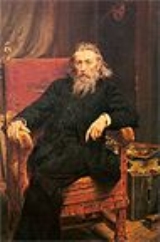
Jan Matejko
Encyclopedia
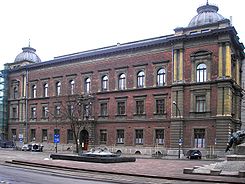
Poland
Poland , officially the Republic of Poland , is a country in Central Europe bordered by Germany to the west; the Czech Republic and Slovakia to the south; Ukraine, Belarus and Lithuania to the east; and the Baltic Sea and Kaliningrad Oblast, a Russian exclave, to the north...
painter
Painting
Painting is the practice of applying paint, pigment, color or other medium to a surface . The application of the medium is commonly applied to the base with a brush but other objects can be used. In art, the term painting describes both the act and the result of the action. However, painting is...
known for paintings of notable historical Polish political and military events. His most famous works include oil on canvas
Oil on Canvas
Oil on Canvas is a live album by the British band Japan, released in 1983 by Virgin Records. Although it is a live recording of their established material, the album also contains three new studio tracks , recorded separately by Sylvian, Sylvian/Jansen and Barbieri respectively...
paintings like Battle of Grunwald
Battle of Grunwald (painting)
The Battle of Grunwald is a painting by Jan Matejko, on the subject of the Battle of Grunwald.-External links:* *...
, paintings of numerous other battles and court
Noble court
The court of a monarch, or at some periods an important nobleman, is a term for the extended household and all those who regularly attended on the ruler or central figure...
scenes, and a gallery of Polish kings. He is counted among the most famous Polish painters.
Biography
Matejko born on June 24, 1838 in the Free City of KrakówFree City of Kraków
The Free, Independent, and Strictly Neutral City of Kraków with its Territory , more commonly known as either the Free City of Kraków or Republic of Kraków , was a city-state created by the Congress of Vienna in 1815, and controlled by its three neighbours until 1846, when in the aftermath of the...
. His father, Franciszek Ksawery Matejko (b. 1789 or 13 January 1793, d. 26 October 1860), a Czech from the village of Roudnice
Roudnice
Roudnice is a village in Hradec Králové Region in Eastern Bohemia, the Czech Republic. It is a birthplace of František Xaver Matějka , father of famous Polish painter Jan Matejko. In addition, the Olympic water polo player Kurt Epstein grew up in Roudnice....
, was a graduate of the Hradec Králové
Hradec Králové
Hradec Králové is a city of the Czech Republic, in the Hradec Králové Region of Bohemia. The city's economy is based on food-processing technology, photochemical, and electronics manufacture. Traditional industries include musical instrument manufacturing – the best known being PETROF pianos...
school; who later became a tutor and music teacher. He first worked for the Wodzicki family in Kościelniki, Poland, then moved to Kraków
Kraków
Kraków also Krakow, or Cracow , is the second largest and one of the oldest cities in Poland. Situated on the Vistula River in the Lesser Poland region, the city dates back to the 7th century. Kraków has traditionally been one of the leading centres of Polish academic, cultural, and artistic life...
, where he married the half-German
Germans
The Germans are a Germanic ethnic group native to Central Europe. The English term Germans has referred to the German-speaking population of the Holy Roman Empire since the Late Middle Ages....
, half-Polish
Poles
thumb|right|180px|The state flag of [[Poland]] as used by Polish government and diplomatic authoritiesThe Polish people, or Poles , are a nation indigenous to Poland. They are united by the Polish language, which belongs to the historical Lechitic subgroup of West Slavic languages of Central Europe...
Joanna Karolina Rossberg. Jan was the ninth child from eleven that his parents had. After the death of his mother in 1846, Jan and his siblings were taken care of by his aunt, Anna Zamojska.
From his earliest days Matejko showed exceptional artistic talent that allowed him to advance from grade to grade, although he had great difficulty with other subjects. He never mastered a foreign language and did not do well even with his native Polish language
Polish language
Polish is a language of the Lechitic subgroup of West Slavic languages, used throughout Poland and by Polish minorities in other countries...
. As a result, the public appearances he was obliged to make all his life must have been difficult for him.
At a young age he witnessed the Kraków revolution
Kraków Uprising
The Kraków Uprising of February 1846 was an attempt, led by Edward Dembowski, to incite a Polish fight for national independence. Even though most of Poland was part of the Russian Empire, the Polish risings were conducted mainly in Prussia and in the Austrian Empire.-History:Most of the...
of 1846 and the 1848 siege of Kraków by the Austrians, the two events which ended the existence of the Free City of Kraków
Free City of Kraków
The Free, Independent, and Strictly Neutral City of Kraków with its Territory , more commonly known as either the Free City of Kraków or Republic of Kraków , was a city-state created by the Congress of Vienna in 1815, and controlled by its three neighbours until 1846, when in the aftermath of the...
. His two older brothers served in them under General Józef Bem
Józef Bem
Józef Zachariasz Bem was a Polish general, an Ottoman Pasha and a national hero of Poland and Hungary, and a figure intertwined with other European nationalisms...
, one died and the other was forced into exile.
He attended St. Ann's High School, which he dropped out of in 1851 because of poor results. Despite that and because of his exceptional talent he studied at the School of Fine Arts in Kraków from 1852 to 1858. His teachers included Wojciech Korneli Stattler and Władysław Łuszczkiewicz. During this time, he began exhibiting historical paintings at the Society of Friends of the Fine Arts there (see e.g. Sigismund I
Sigismund I
Sigismund I may refer to:*Sigismund of Burgundy , King of the Burgundians*Sigismund, Holy Roman Emperor *Sigismund, Archduke of Austria *Sigismund of Bavaria , Duke of Bavaria...
Bestowing Nobility on the Professors of the University of Kraków in 1535.). After studying under the historical painter Hermann Anschütz
Hermann Anschütz
Hermann Anschütz was a German painter and professor at the Royal Academy of Fine Arts in Munich.Anschütz was born in Koblenz. It is traced, that he lived at Promenade Straße 1 in Munich around 1850. He died in Munich, where he was buried on the Old Southern Cemetery .-External links:* * -...
in Munich
Munich
Munich The city's motto is "" . Before 2006, it was "Weltstadt mit Herz" . Its native name, , is derived from the Old High German Munichen, meaning "by the monks' place". The city's name derives from the monks of the Benedictine order who founded the city; hence the monk depicted on the city's coat...
(1859) and then briefly and less successfully in Vienna
Vienna
Vienna is the capital and largest city of the Republic of Austria and one of the nine states of Austria. Vienna is Austria's primary city, with a population of about 1.723 million , and is by far the largest city in Austria, as well as its cultural, economic, and political centre...
, Matejko returned to Kraków. It would be however years before he would gain commercial success; for a time he was the proverbial "starving artist", who celebrated when he sold a canvass (Tsars Szujscy) for five gulden
Austro-Hungarian gulden
The Gulden or forint was the currency of the Austrian Empire and later the Austro-Hungarian Empire between 1754 and 1892 when it was replaced by the Krone/korona as part of the introduction of the gold standard. In Austria, the Gulden was initially divided into 60 Kreuzer, and in Hungary, the...
.
During the January Uprising
January Uprising
The January Uprising was an uprising in the former Polish-Lithuanian Commonwealth against the Russian Empire...
of 1863 in which he did not participate because of poor health, Matejko gave financial support and transported arms
Gunrunning
Arms trafficking, also known as gunrunning, is the illegal trafficking or smuggling of contraband weapons or ammunition.The 1997 Report of the UN Panel of Governmental Experts on Small Arms provides a more refined and precise definition, which has become internationally accepted...
to the insurgents' camp in Goszcza
Goszcza
Goszcza is a village in the administrative district of Gmina Kocmyrzów-Luborzyca, within Kraków County, Lesser Poland Voivodeship, in southern Poland. It lies approximately north-east of the regional capital Kraków....
). In 1864 he married Teodora Giebultowska
Teodora Matejko
Teodora Matejkowa, née Giebułtowska , - the daughter of Antoni Giebułtowski and Paulina Sikorska, and the wife of the Polish painter Jan Matejko....
, with whom he had four children: Beata, Helena
Helena Unierzyska
Helena Matejko Unierzyski - Polish painter and sculptor, daughter of Jan Matejko and Teodora Giebułtowka.- Biography :During her infancy she lived with her parents in Krzesławice and Cracow. She was very sickly when she was a child. On 24 June 1891 she married a painter Józef Unierzyski. After...
, Tadeusz, and Jerzy. In the same year he became a member of Scientific Society in Kraków. Tadeusz, his first son, was a painter who studied under his father's supervision. Helena, his daughter, also an artist, was a patriot
Patriotism
Patriotism is a devotion to one's country, excluding differences caused by the dependencies of the term's meaning upon context, geography and philosophy...
who helped victims in World War I
World War I
World War I , which was predominantly called the World War or the Great War from its occurrence until 1939, and the First World War or World War I thereafter, was a major war centred in Europe that began on 28 July 1914 and lasted until 11 November 1918...
and was awarded the Cross of Independence
Cross of Independence
Cross of Independence was one of the highest Polish military decorations between World Wars I and II. It was awarded to individuals who had "fought heroically for the independence of Poland," and was released in three versions.- History :...
by president
President
A president is a leader of an organization, company, trade union, university, or country.Etymologically, a president is one who presides, who sits in leadership...
Stanisław Wojciechowski.
At that time Matejko started to gain international recognition; literally a starving artist
Starving artist
A starving artist is an artist who sacrifices material well-being in order to focus on their artwork. They typically live on minimum expenses, either for a lack of business or because all their disposable income goes toward art projects....
during his younger days. In 1865 Matejko's painting "Skarga
Piotr Skarga
Piotr Skarga was a Polish Jesuit, preacher, hagiographer, polemicist, and leading figure of the Counter-reformation in the Polish-Lithuanian Commonwealth. He was called the "Polish Bossuet" due to his oratorical abilities.He was born February 2, 1536 in Grójec, to a family of lesser landless gentry...
's Sermon" was awarded a gold medal at the yearly Paris salon; soon afterwards Count Maurycy Potocki bought it for 10,000 gulden
Austro-Hungarian gulden
The Gulden or forint was the currency of the Austrian Empire and later the Austro-Hungarian Empire between 1754 and 1892 when it was replaced by the Krone/korona as part of the introduction of the gold standard. In Austria, the Gulden was initially divided into 60 Kreuzer, and in Hungary, the...
s. In 1868, his painting "Rejtan" was awarded a gold medal at the World Exhibition in Paris. Critics listed Matejko as one of the most important European historical painters. From the Polish perspective, he succeeded in propagating the Polish history, and reminding the world about Poland, which while partitioned and without any independent political representation, still commanded the hearts of many.
Beginning in 1873, he was for many years the principal of the Academy of Fine Arts.
Matejko died in Kraków on November 1, 1893. He was buried in the center of the Alley of the Meritorious at Kraków's Rakowicki Cemetery
Rakowicki Cemetery
Rakowicki Cemetery is one of the best known cemeteries of Poland, located in the centre of Kraków. It lies within the Administrative District No. 1 Stare Miasto meaning "Old Town" – not to be confused with the historic Kraków Old Town further west...
.
Works

Warsaw
Warsaw is the capital and largest city of Poland. It is located on the Vistula River, roughly from the Baltic Sea and from the Carpathian Mountains. Its population in 2010 was estimated at 1,716,855 residents with a greater metropolitan area of 2,631,902 residents, making Warsaw the 10th most...
's Zachęta
Zacheta
The Zachęta National Gallery of Art, short Zachęta, , is one of Poland's most notable institutions for contemporary art. Situated in the centre of Warsaw, the main aim of the gallery is to present and support primarily Polish contemporary art and artists...
. The national defeats forced him to abandon the Christian religious painting
Christian art
Christian art is sacred art produced in an attempt to illustrate, supplement and portray in tangible form the principles of Christianity, though other definitions are possible. Most Christian groups use or have used art to some extent, although some have had strong objections to some forms of...
which, he believed, was his vocation and to devote himself almost exclusively to historical painting. In fact he created a vision of Polish history from which we can not liberate ourselves despite of perennial criticism of the scientists. Matejko often placed on his paintings people who were not present at this location (f.ex. Hugo Kołłątaj, and General Józef Wodzicki, on The Battle of Racławice). He was not interested in presenting factual events but in representation of a historical-philosophical synthesis. Matejko's work has to be viewed not only in artistic terms, but also in terms of the social function it performed and continues to perform today. He considered history as a function of the present and the future. His paintings are not historical illustrations, rather they are powerful expressions of the artist's psyche and his attitude to the world.
Historical themes
Matejko was focusing on major themes in Polish history and using historical sources to paint events in minute historical detail. He created two groups of historical paintings. The earlier one starting with the painting StańczykStanczyk
Stańczyk was the most famous court jester in Polish history. He was employed by three Polish kings: Alexander, Sigismund the Old and Sigismund Augustus.- Name, identity and historicity:...
(1862) was directed against the magnates whose lack of patriotism
Patriotism
Patriotism is a devotion to one's country, excluding differences caused by the dependencies of the term's meaning upon context, geography and philosophy...
caused, in his opinion, the fall of Poland. Stanczyk, the court jester to King Sigismund I
Sigismund I
Sigismund I may refer to:*Sigismund of Burgundy , King of the Burgundians*Sigismund, Holy Roman Emperor *Sigismund, Archduke of Austria *Sigismund of Bavaria , Duke of Bavaria...
(1437–1548), to whom Matejko gave his own features. The jester is presented as a symbol of the nation's conscience: he sits glumly in a chair apart from the other figures, alone in seeing that events during the wars against Moscow would ultimately end in tragedy. This group of paintings included among others also Kazanie Skargi (Sermon of Piotr Skarga
Piotr Skarga
Piotr Skarga was a Polish Jesuit, preacher, hagiographer, polemicist, and leading figure of the Counter-reformation in the Polish-Lithuanian Commonwealth. He was called the "Polish Bossuet" due to his oratorical abilities.He was born February 2, 1536 in Grójec, to a family of lesser landless gentry...
) (1864) and Reytan (1866).
The second group, painted after the defeat of January Uprising
January Uprising
The January Uprising was an uprising in the former Polish-Lithuanian Commonwealth against the Russian Empire...
, is dedicated to famous events in Polish history. Matejko depicted many major events and battles in Polish history. His most famous work is Bitwa pod Grunwaldem (Battle of Grunwald
Battle of Grunwald
The Battle of Grunwald or 1st Battle of Tannenberg was fought on 15 July 1410, during the Polish–Lithuanian–Teutonic War. The alliance of the Kingdom of Poland and the Grand Duchy of Lithuania, led respectively by King Jogaila and Grand Duke Vytautas , decisively defeated the Teutonic Knights, led...
) (1878) depicting the 1410 Polish and Lithuanian victory over the Teutonic Knights
Teutonic Knights
The Order of Brothers of the German House of Saint Mary in Jerusalem , commonly the Teutonic Order , is a German medieval military order, in modern times a purely religious Catholic order...
; a painting showing "clearly nationalist endeavour" which garnered it international acclaim as "an unrivaled icon of Polish nationalism". Other paintings in this group include Unia Lubelska (Union of Lublin
Union of Lublin
The Union of Lublin replaced the personal union of the Kingdom of Poland and the Grand Duchy of Lithuania with a real union and an elective monarchy, since Sigismund II Augustus, the last of the Jagiellons, remained childless after three marriages. In addition, the autonomy of Royal Prussia was...
) (1869), Stefan Batory pod Pskowem (Stefan Batory
Stefan Batory
Stephen Báthory was a Hungarian noble Prince of Transylvania , then King of Poland and Grand Duke of Lithuania . He was a member of the Somlyó branch of the noble Hungarian Báthory family...
at the siege of Pskov
Siege of Pskov
The Siege of Pskov, known as the Pskov Defense in Russia took place between August of 1581 and February of 1582, when the army of the Polish king and Grand Duke of Lithuania Stefan Batory laid an unsuccessful siege and successful blockade of the city of Pskov during the final stage of the Livonian...
) (1872), Kopernik (Nicolaus Copernicus
Nicolaus Copernicus
Nicolaus Copernicus was a Renaissance astronomer and the first person to formulate a comprehensive heliocentric cosmology which displaced the Earth from the center of the universe....
), Dzwon Zygmunta (Sigismund's Bell) (1874), Hołd Pruski (Prussian Tribute) (1882), Sobieski pod Wiedniem (Jan III Sobieski at the Battle of Vienna
Battle of Vienna
The Battle of Vienna took place on 11 and 12 September 1683 after Vienna had been besieged by the Ottoman Empire for two months...
) (1883), Wernyhora
Wernyhora
Wernyhora is a legendary 18th century Cossack bard who prophetized the fall of Poland as well as its eventual rebirth. He has been a subject of several folklore tales and poems...
, Kościuszko pod Racławicami (Tadeusz Kościuszko
Tadeusz Kosciuszko
Andrzej Tadeusz Bonawentura Kościuszko was a Polish–Lithuanian and American general and military leader during the Kościuszko Uprising. He is a national hero of Poland, Lithuania, the United States and Belarus...
at the battle of Racławice) (1888), Dzieje Cywilizacji w Polsce (History of civilization in Poland) (1889) and Konstytucja 3 Maja (Constitution of the 3 May) (1891). From 1890 to 1892 he also painted all of the Polish kings compiled in his book Portraits of Polish Kings (1890); his dedication to detail is evident in that he attended the opening of Queen Jadwiga's sarcophagus
Sarcophagus
A sarcophagus is a funeral receptacle for a corpse, most commonly carved or cut from stone. The word "sarcophagus" comes from the Greek σαρξ sarx meaning "flesh", and φαγειν phagein meaning "to eat", hence sarkophagus means "flesh-eating"; from the phrase lithos sarkophagos...
in 1887 to make sketches of her skull.
In addition to historical events Matejko made also several portraits. Among others: Żona w sukni ślubnej ("Wife in the wedding dress") (1879), A. Potocki (1879), S. Tarnowski (1890), Autoportret (1892). Altogether Matejko authored 320 oil paintings and several thousands drawings and watercolors. Finally he painted a monumental polychrome
Polychrome
Polychrome is one of the terms used to describe the use of multiple colors in one entity. It has also been defined as "The practice of decorating architectural elements, sculpture, etc., in a variety of colors." Polychromatic light is composed of a number of different wavelengths...
in St. Mary's Basilica, Kraków
St. Mary's Basilica, Kraków
St. Mary's Basilica , is a Brick Gothic church re-built in the 14th century , adjacent to the Main Market Square in Kraków, Poland...
(1889–1891). His most important paintings were hidden during World War II (Bitwa pod Grunwaldem was buried in Lublin
Lublin
Lublin is the ninth largest city in Poland. It is the capital of Lublin Voivodeship with a population of 350,392 . Lublin is also the largest Polish city east of the Vistula river...
). After 1945 majority of his works was found and subject to restoration
Art conservation and restoration
Conservation-restoration, also referred to as conservation, is a profession devoted to the preservation of cultural heritage for the future. Conservation activities include examination, documentation, treatment, and preventive care...
. They are now mainly in Warsaw's National Museum (Muzeum Narodowe w Warszawie). His works, disseminated in thousands of reproductions, have made him one of the most famous painters in Poland, and became almost standard illustrations of many key events in Polish history.
Students
His more prominent students included Maurycy GottliebMaurycy Gottlieb
Maurycy Gottlieb was a Jewish painter, of Polish-speaking Galician Jews from the western part of Ukraine. He was born in Drohobych , Galicia, modern Lviv region, western Ukraine....
, Jacek Malczewski
Jacek Malczewski
Jacek Malczewski was one of the most famous painters of Polish Symbolism. In his creativity he successfully joins the predominant style of his times with motifs of Polish martyrdom.-See also:...
, Józef Mehoffer
Józef Mehoffer
Józef Mehoffer was a Polish painter and decorative artist, one of the leading artists of the Young Poland movement and one of the most revered Polish artists of his time.-Life:...
, Witold Pruszkowski
Witold Pruszkowski
Witold Pruszkowski was a Polish painter and draughtsman.Pruszkowski lived his youth in Odessa and Kiev. He later went to Paris where he served an apprenticeship under the renowned portrait painter Tadeusz Gorecki. He continued his studies in Munich and then Kraków under Jan Matejko...
, Leon Wyczółkowski, Stanisław Wyspiański, Ephraim Moses Lilien, Antoni Piotrowski
Antoni Piotrowski
Antoni Piotrowski was a Polish Romanticist and Realist painter.Piotrowski was born in Nietulisko Duże in 1853 near Kunów, then in the Russian Empire , to a sheet iron worker. From 1869 on, Piotrowski studied painting with professor Wojciech Gerson...
.
List of works
Below is the list of Matejko's most famous works, in a chronological order.| # | Title | Year | Technique and size | Location | Illustration |
| 1. | Stańczyk Stańczyk (painting) The Stańczyk is a painting by Jan Matejko finished in 1862. The full title of the painting is Stańczyk w czasie balu na dworze królowej Bony wobec straconego Smoleńska... (Stańczyk w czasie balu na dworze królowej Bony gdy wieść przychodzi o utracie Smoleńska) |
1862 | oil on canvas 120 × 88 cm |
National Museum, Warsaw | 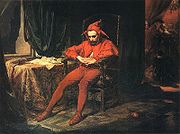 |
| 2. | Kazanie Skargi | 1864 | oil on canvas 224 × 397 cm |
Royal Castle, Warsaw Royal Castle, Warsaw The Royal Castle in Warsaw is a castle residency and was the official residence of the Polish monarchs. It is located in the Castle Square, at the entrance to the Warsaw Old Town. The personal offices of the king and the administrative offices of the Royal Court of Poland were located there from... |
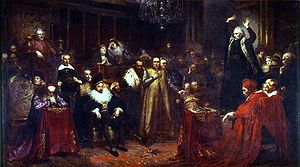 |
| 3. | Polonia - Rok 1863 (Zakuwana Polska) |
1864? 1879 |
oil on canvas 156 × 232 cm |
Czartoryski Museum, Kraków Czartoryski Museum The Czartoryski Museum and Library is a museum located in Kraków, Poland, founded in Puławy in 1796 by Princess Izabela Czartoryska. The Puławy collections were partly destroyed after the November uprising of 1830–1831 and the subsequent confiscation of the Czartoryskis' property by the Russians... |
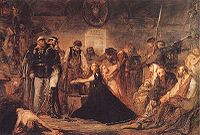 |
| 4. | Rejtan – Upadek Polski | 1866 | oil on canvas 282 × 487 cm |
Royal Castle, Warsaw | 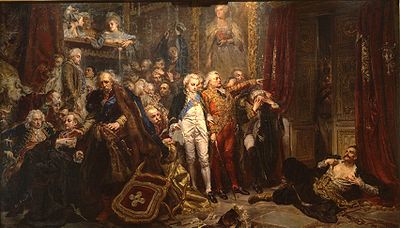 |
| 5. | Unia Lubelska | 1869 | oil on canvas 298 cm × 512 cm |
Lublin Museum | 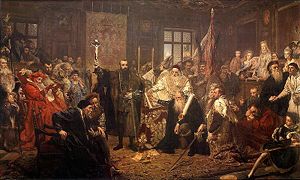 |
| 6. | Stefan Batory pod Pskowem | 1872 | oil on canvas 322 × 545 cm |
Royal Castle, Warsaw | 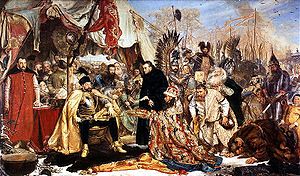 |
| 7. | Astronom Kopernik, czyli rozmowa z Bogiem | 1873 | oil on canvas 225 × 315 cm |
Collegium Novum Uniwersytetu Jagiellońskiego |  |
| 8. | Zawieszenie dzwonu Zygmunta | 1874 | oil on wood 94 × 189 cm |
National Museum, Warsaw | 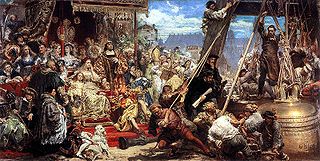 |
| 9. | Śmierć króla Przemysła II | 1875 | Modern Gallery in Zagreb | ||
| 10. | Bitwa pod Grunwaldem | 1878 | oil on canvas 426 × 987 cm |
National Museum, Warsaw | 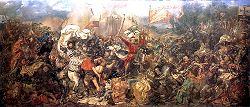 |
| 11. | Hołd pruski | 1880-82 | oil on canvas 388 × 875 cm |
National Museum, Kraków |  |
| 12. | Jan III Sobieski pod Wiedniem | 1883 | Vatican Museums | 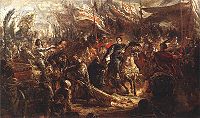 |
|
| 13. | Wernyhora | 1883-84 | oil on canvas 290 × 204 cm |
National Museum, Kraków |  |
| 14. | Założenie Akademii Lubrańskiego w Poznaniu | 1886 | National Museum, Poznań National Museum, Poznań The National Museum, Poznań , Poland, is a national institution of culture and one of the largest museums in Poland. It comprise a rich collection of Polish painting since the 16th century and a collection of foreign painting... |
||
| 15. | Bitwa pod Racławicami | 1888 | oil on canvas 450 × 890 cm |
National Museum, Kraków |  |
| 16. | cycle Dzieje cywilizacji w Polsce | 1888 | |||
| 17. | Zaprowadzenie chrześcijaństwa | 1889 | oil on wood 79 × 120 cm |
National Museum, Warsaw | 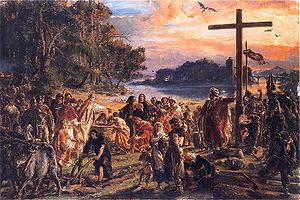 |
| 18. | Konstytucja 3 Maja 1791 r. | 1891 | oil on canvas 247 cm × 446 cm |
Royal Castle, Warsaw | 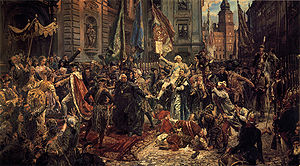 |
| 19. | Union of Lublin | 1892 | oil on wood 42 cm × 63 cm |
Jan Matejko House in Kraków | 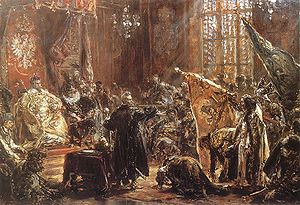 |
Further reading
JSTORExternal links
- Jan Matejko 1838-1893
- Jan Matejko 1838-1893
- "CLOTHING AND COSTUMES..." From the Collection of Jan Matejko
- "THE GREAT ILLUSTRATOR - THE WOODCUTS OF JAN MATEJKO"
- JAN MATEJKO'S HOUSE
- "ARTISTS FROM THE SCHOOL OF JAN MATEJKO"
- A gallery of paintings with links to biography (289 words) and bibliographical pages (12 books).
- www.Jan-Matejko.org Jan Matejko Virtual Gallery - 64 images by the artist.
- A gallery of paintings by Matejko.
- Wawel gallery
- Jan Matejko's artwork at malarze.com
- Matejko's Gallery of Polish Kings
- Gallery at Omikron

